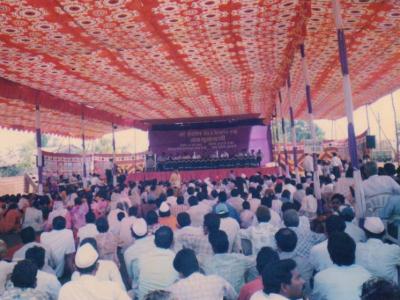Working towards inclusive and sustainable socio-economic
development...
Resources
Success Stories >>
> Women Leadership -Exploring New Horizons
> Dakshata Samities - A Countervailing Power to Corruption
> Hearing People's Voice - Multi Stakeholders Dialogue >>
> Fight for Justice - Women Federation Enforced Re-execution of 'National Health Insurance Scheme'
> Revolving Fund - Marching Towards Economic Security
> Bringing Technology to Grssroots - Reverse Osmosis Water Treatment Unit
Resources > Success Stories > Hearing People's Voice - Multi Stakeholders Dialogue >
Hearing People's Voice - Multi Stakeholders Dialogue

Parallel to the activities with civil organizations, Parivartan also recognized the need & importance of building dialogue with the government authorities. Perhaps, Parivartan tried to bridge up the age-old communication gap between the local communities and government mechanism. Along with creating awareness in communities on the issues related to industrialization & its effects, Parivartan made the government mechanism to share the same platform for face to face dialogue with the affected communities. The strategic use of tool "Jansunavani" added a big force to the intervention.
This tool was based on a detailed study of effects of industrial pollution on lives and livelihoods of local communities and local natural resources. Parivartan partnered with "Society for Participatory Research in Asia" (PRIA, N. Delhi) for completing this study.
Public hearing was organized on 14th March, 1999, with a strong belief in the fact that the crisis arising out of industrialization and pollution could be tackled only based on people's action in collaboration (and not always confrontation) with the industries and government.
With an objective to raise a collective action of government, industrialists & experts for generating the solutions over the loss of natural resources and livelihoods in the belt, a 'Jansunavani' was organized at Asgani village in Khed block of Ratnagiri district. This 'Janasunavani' was the first of its kind event that brought all the stakeholders on the same platform.
One day before the hearing, a team of government officials and NGO activists were taken for a visit around the industrial area to assess the extent of damage. The areas visited were Lote, Songaon & Bhile (affected villages in Lote Industrial Area).
During 'Jansunavani' the local communities presented their concerns over the need to balance the industrial development with the sustainability of the environment. Perhaps it was not just presentation of problems by community; a development plan was also prepared & presented by the community as a solution to their problems. A development plan was the plan for coexistence of the people & industries and thus it also presented local wisdom in front of experts all over the country. Presentation of the development plan by community was the special merit of the 'Jansunavani'.
The key issues discussed during the 'Janasunavani' were, problems faced by the people due to loss of land, MIDC extension and employment, problems due to pollution and effluent pipe line and difficulties faced by women. Development plan presentations were made by community people, NGO activists, government officials and the doctors who were involved in the medical examination.
Follow-up of the 'Janasunavani'
To increase comprehensive awareness and follow up, a report and video cassette on public hearing was prepared immediately. As a part of follow-up activity of issues, a meeting was conducted with M.I.D.C. state level officials on 17th July, 1999 at M.I.D.C. Mumbai office. Representatives of Dakshata committees of the affected villages participated in this meeting. The issues pursued were, unrecorded tenants issue, compensation of land acquired by MIDC, compensation of property on acquired land, compensation for loss of properties due to pollution, construction of C.E.T.P. & renovation of effluent carrying pipeline.
Outcome of the 'Janasunavani'
The government mechanisms accepted their inefficiency & agreed to make every possible change as per the 'Development Plan'. MIDC assured to establish the Common Effluent Treatment Plant (CETP). Also the renovation of effluent carrying pipeline was carried out. These actions were a major relief for the residents of lote belt. Apart from these key measures following actions were taken by the authorities in order to resolve the issues,
> Payment of landlord was suspended so that unrecorded tenants can get justice
> 40 ha. of land from Asgani village and Mohalla was exempted from acquired land
> Special land acquisition officer was given the orders for revaluation of property on acquired land
> Revenue department was given order to compensate the loss of property (farms, horticulture, etc.) due to pollution
Though MIDC had assured to set up the CETP in LIA, the actual implementation of the decision was being delayed. In this regard "Chargaon Sangharsh Samiti" had filed a petition against Maharashtra government, MIDC, Collector & MPCB (Maharashtra Pollution Control Board). In turn high court appointed a committee to measure the intensity of air, water & land (soils) pollution in LIA. The committee of renowned scientists from BARC, IIT-Mumbai, MIDC & MPCB was formed. Court ordered the industrialists to develop a green belt, CETP/ solid waste treatment plant and air & water pollution testing laboratories.
In Lote Industrial area, due to DS's intervention, 11 polluting industries were closed down, CETP was installed and 20% of the agricultural land was reclaimed from acquired area.
The study & Jansunavani event proved to be an event that realigned the thinking process among people who started questioning the industries and reasoning with the reality. They started analyzing the situation and became aware of their rights. From the initial reaction of hostility, they started weighing the pros and cons of the presence of industries and realized that the solution does not lie in closure of industries but in devising a mutually benefiting relationship.